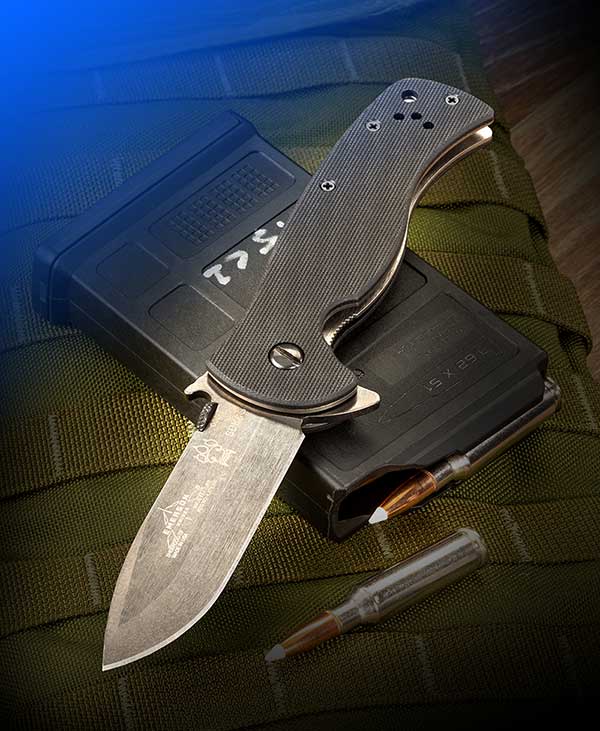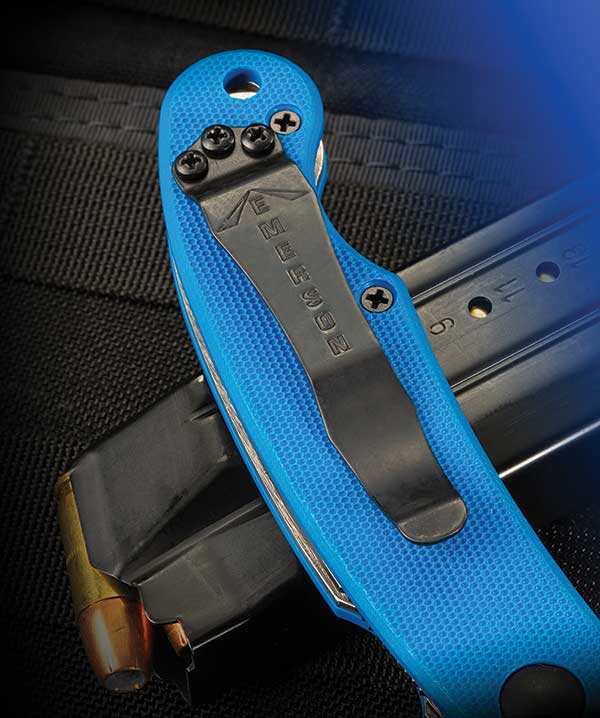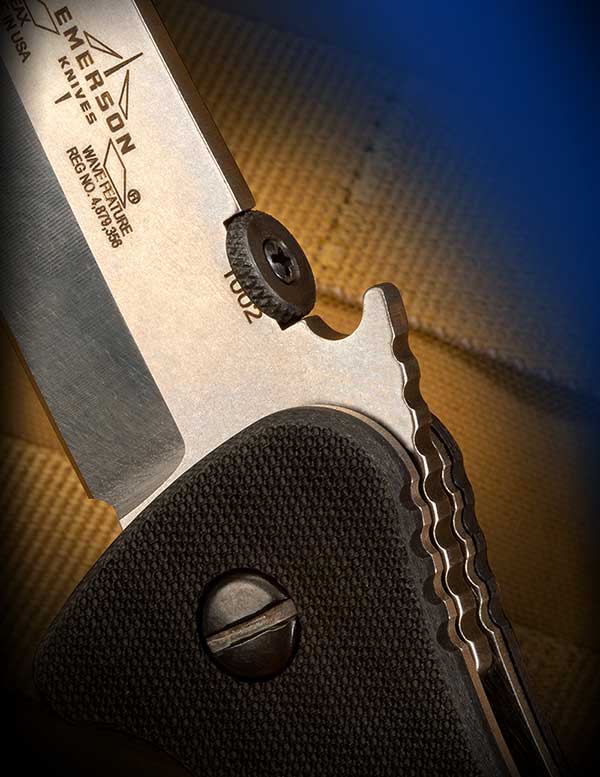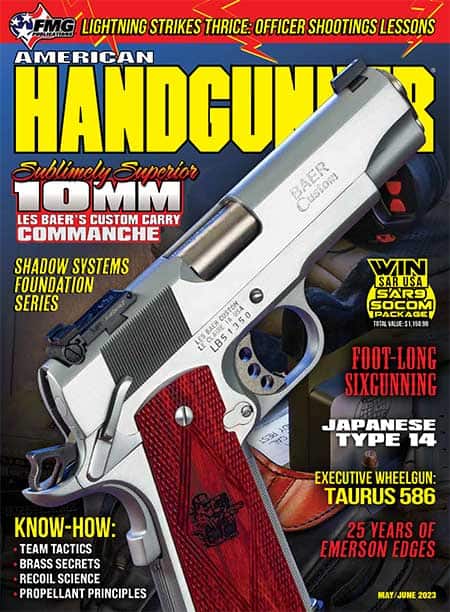Emerson Edges
Emerson Knives blows past 25 years of excellence.
When the first Gulf War in Iraq rocked the world in 1990, little did those in the cutlery industry know they were about to witness the most explosive times in their history. A handful of custom knifemakers had been working on modernized tactical folding knives geared for combat using newer technology, and the Gulf War gave them the perfect opportunity to roll them out. Ernest Emerson was one of those, and the demand for his “combat folders” went through the roof. Ernest “Ernie” Emerson went on to form Emerson Knives in 1996, and he’s been in the factory knife business ever since, spreading the love of his popular tactical knife designs the world over.
Fighting And Field Fare
Emerson is a highly skilled martial artist, and his designs are fighting knives at heart — but most are also excellent working knives in both urban and outdoor environments. The Emerson Sheepdog series embraces that “field or fight” philosophy in spades. There are two versions of the Sheepdog — a Drop Point and Bowie — both checking in at 8.4″ fully extended. The Drop Point is featured here, but aside from the blade configuration, the specs are pretty much the same. The 3.5″ blade has a V-ground chiseled (or “zero” grind) edge, meaning there is no secondary grind on the cutting edge. A false grind on the lead edge of the spine enhances penetration. There are three opening options: a standard, disc-shaped ambidextrous thumb stud, a flipper, or Emerson’s patented Wave feature, which allows the blade to be hooked on the lip of a pocket for rapid deployment while the knife is being drawn. The blade is 154CM stainless steel and can be had in a black-coated or stonewashed finish.
The Sheepdog’s 4.9″ handle is plenty for even large mitts, but Emerson keeps the weight down to 5.0 oz. by using Titanium liners and G10 composite scales. Inside the frame, you’ll find a ball-bearing pivot for super-smooth rollout and a liner-lock mechanism for keeping the blade secured when fully opened. For carry, there’s a sturdy pocket clip on the backside mounted for tip-up carry.
“Seax” is an Anglo-Saxon word for “short sword” and Emerson’s tactical folder version pays homage to the flat-edged Viking version, which was used for a wide range of utility chores by hunters, fishermen, woodworkers and other tradesmen alike. The flat-edged blade has also proven to be a worthy blade style on modern combat knives.
At 9.0″ overall, the Emerson Seax is a large folder with 3.9″ devoted to a wicked flat-edged blade similar to a Wharncliffe but with a clipped spine instead of a curve. The Seax’s 154CM stainless blade can be opened by a disc thumb stud or Emerson’s rapid-fire Wave feature. The Seax’s 4.9″ handle has plenty of curve and features Emerson’s time-tested duo of checkered G10 scales over Titanium liners. Here again, there’s a sturdy liner lock residing between the frame slabs and an ample tip-up pocket clip is mounted on the rear slab. If you’re looking for a good-sized folder that can do it all, the Seax will serve you well.
A Throwback EDC
The Emerson A-100 hearkens back to the early 1990s when the modern tactical folder genre was getting its sea legs. Innovative custom knifemaker Michael Walker’s locking-liner design took the knife world by storm and was a must-have on the new tactical fare. The A-100 reflects the simple styling of the period — a simple straight handle design, a combat-worthy blade and a liner lock. In fact, Ernest already had the A-100 in the can, ready to roll, when the modern tactical movement took off.
The A-100 is 8.4″ overall, with 3.6″ devoted to a very pointy Drop Point blade. The blade steel is 154CM stainless with a false grind on the spine for enhanced penetration. A thumb disc does the opening chores and the liner lock keeps the blade positively locked when deployed — and safely tucked away when stowed. Without all the bells and whistles found on tactical folders today, the A-100 more resembles a gentleman’s EDC. And there’s nothing wrong with that, but some days a worthy knife with clean styling is all you need.
Reverse Grip Grabber
The Emerson Elvia is considered a wicked combat knife used in Filipino martial arts, but its roots are in a humble fruit knife called the “Pikal.” This is not unusual, as many different utilitarian blade styles from the world over have been modified to suit tactical/combat knives. What makes the Elvia really “different” is that it’s a reverse-grip knife made for slashing in an arch and pulling toward the user, much like the popular Karambit.
Emerson worked with Ed Calderon, a legendary lawman from northern Mexico known for using and later refining his mother’s Pikal-style fruit knife for fighting narco-terrorist types in his raids. The results are the Elvia and Elvia Trainer you see here. Fully extended, the Elvia is 7.2″ long, 3.2″ dedicated to its Hawkbill-esque blade. Emerson chose preferred, time-proven 154CM stainless for blade steel with a flat V-grind for the slicing chores, and, like most Emerson fare, it can be had in black or satin finish. The blade opens via an ambidextrous thumb disc and snicks firmly into place via a liner lock. The curved handle is meant to be used upside-down in the reverse grip and is decked out in G10 scales over beefy Titanium liners. A black-coated stainless steel pocket clip completes the package.
The Elvia Trainer differs in that the handle scales are a bright blue checkered G10, and the blade is a blunt-tipped, unsharpened profile of the original with lightening holes to more accurately mimic its weight. To their credit, Emerson offers trainers on a nice handful of their knives.
Just The Facts
Ernest Emerson was already an accomplished, well-known custom knifemaker when the modern tactical movement exploded over 25 years ago. His knowledge of martial arts and close quarter-edged-weapons combat influenced his designs before the First Gulf War ever lit the fire. Many of his mid-1990s designs, such as his CQC series, are every bit as relevant today as they were then and influenced many knifemakers and manufacturers along the way. You won’t see Emerson Knives busting their butts to release new models at the big shows every year because, well, they don’t need to. The knives they offered back then and since have everything pertinent you need now. And that’s a fact.
For more info: EmersonKnives.com










